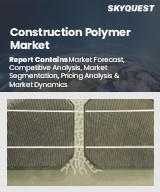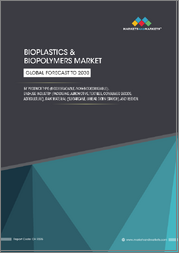
|
시장보고서
상품코드
1702306
바이오 기반 폴리머 시장 규모, 점유율, 동향, 예측 : 유형별, 용도별, 지역별(2025-2033년)Bio-Based Polymer Market Size, Share, Trends and Forecast by Type, Application, and Region, 2025-2033 |
||||||
바이오 기반 폴리머 세계 시장 규모는 2024년 85억 달러에 달했습니다. 향후 IMARC Group은 2033년에는 136억 2,000만 달러에 달할 것으로 예상하며, 2025-2033년 연평균 5.38%의 CAGR을 기록할 것으로 예상하고 있습니다. 다양한 정부 규제 및 정책 시행, 지속가능한 포장에 대한 수요 증가, 바이오플라스틱 생산에 대한 투자 증가, 바이오 기반 폴리머 재료의 급속한 발전 등이 시장을 발전시키는 요인 중 일부입니다.
바이오 기반 폴리머란 조류, 미생물, 식물 등의 생물자원에서 얻은 수지를 말합니다. 직접 합성되거나 단량체 합성 후 중합됩니다. 제조에 사용되는 주요 바이오매스 원료는 일반적으로 생물 유래 제품별, 특히 바이오디젤 생산에서 얻은 글리세롤을 포함합니다. 이러한 폴리머는 제조 과정에서 화석 탄소를 바이오매스 유래의 재생 가능한 탄소로 대체할 수 있기 때문에 기존 플라스틱의 대체 솔루션으로 널리 사용되고 있습니다. 이러한 폴리머가 제공하는 장점으로는 식품유지에 대한 내성 향상, 우수한 투명성 및 광택, 높은 향기 차단성, 우수한 비틀림 유지력 및 인쇄성 등이 있습니다. 그 결과, 바이오 기반 폴리머는 식음료(F&B), 농업, 섬유, 전자, 포장, 헬스케어 등 다양한 산업 분야에 적용되고 있습니다.
바이오 기반 폴리머 시장 동향:
시장은 지속가능한 개발에 대한 관심의 증가가 큰 원동력이 되고 있습니다. 기존 플라스틱에 대한 의존도를 줄이는 데 대한 관심이 높아짐에 따라 많은 세계 조직이 음료 및 스낵 포장에 생분해성 식품 등급 대안을 도입하는 것을 추진하고 있습니다. 또한, 전 세계 여러 정부 기관에서 시행하고 있는 유리한 정책과 정책은 시장의 주요 기업들에게 유리한 기회를 창출하고 있습니다. 각국 정부는 합성 폴리머의 채택을 억제할 뿐만 아니라 쇼핑 및 포장 용도로 재래식 플라스틱 사용에 대한 추가 요금을 부과하고 있습니다. 또한, 여러 최종 사용 산업에서 친환경 화학제품으로의 전환이 가속화되고 있는 것도 시장을 견인하고 있습니다. 시장 성장에 기여하는 다른 요인으로는 미생물 발효 공정을 사용하여 제조된 친환경 폴리에틸렌(PE)에 대한 선호도 증가와 생분해성 폴리머의 폐기 용이성에 대한 인식이 높아지는 것을 들 수 있습니다.
본 보고서에서 다루는 주요 질문
- 바이오 기반 폴리머란 무엇인가?
- 세계 바이오 기반 폴리머 시장 규모는?
- 2025-2033년 세계 바이오 기반 폴리머 시장의 예상 성장률은?
- 세계 바이오 기반 폴리머 시장을 이끄는 주요 요인은 무엇인가?
- 바이오 기반 폴리머 시장 유형별 세계 주요 부문은?
- 바이오 기반 폴리머 시장의 주요 용도별 세계 시장 부문은?
- 세계 바이오 기반 폴리머 시장의 주요 지역은?
- 세계 바이오 기반 폴리머 시장의 주요 플레이어/기업은?
목차
제1장 서문
제2장 조사 범위와 조사 방법
- 조사 목적
- 이해관계자
- 데이터 소스
- 1차 정보
- 2차 정보
- 시장 추정
- 상향식 접근
- 하향식 접근
- 조사 방법
제3장 주요 요약
제4장 소개
- 개요
- 주요 업계 동향
제5장 세계의 바이오 기반 폴리머 시장
- 시장 개요
- 시장 실적
- COVID-19의 영향
- 시장 예측
제6장 시장 내역 : 유형별
- 폴리에틸렌(PE)
- 폴리아미드(PA)
- 폴리젖산(PLA)
- 폴리에틸렌 테레프탈레이트(PET)
- 기타
제7장 시장 내역 : 용도별
- 포장
- 텍스타일
- 자동차
- 산업
- 농업
- 기타
제8장 시장 내역 : 지역별
- 북미
- 미국
- 캐나다
- 아시아태평양
- 중국
- 일본
- 인도
- 한국
- 호주
- 인도네시아
- 기타
- 유럽
- 독일
- 프랑스
- 영국
- 이탈리아
- 스페인
- 러시아
- 기타
- 라틴아메리카
- 브라질
- 멕시코
- 기타
- 중동 및 아프리카
- 시장 내역 : 국가별
제9장 SWOT 분석
- 개요
- 강점
- 약점
- 기회
- 위협
제10장 밸류체인 분석
제11장 Porter's Five Forces 분석
- 개요
- 구매자의 교섭력
- 공급 기업의 교섭력
- 경쟁 정도
- 신규 참여업체의 위협
- 대체품의 위협
제12장 가격 분석
제13장 경쟁 구도
- 시장 구조
- 주요 기업
- 주요 기업 개요
- Arkema S.A.
- BASF SE
- Biome Bioplastics Limited
- Corbion N.V.
- FKuR Kunststoff GmbH
- Kuraray Co. Ltd.
- Mitsubishi Chemical Holdings Corporation
- Novamont S.p.A.
- Rodenburg Productie B.V.
- thyssenkrupp AG
- Toray Industries Inc.
The global bio-based polymer market size was valued at USD 8.50 Billion in 2024. Looking forward, IMARC Group estimates the market to reach USD 13.62 Billion by 2033, exhibiting a CAGR of 5.38% from 2025-2033. Asia Pacific currently dominates the market in 2024. The implementation of various government regulations and policies, growing demand for sustainable packaging, increasing investment in bioplastic production, and rapid advancements in bio-based polymer materials, are some of the factors propelling the market forward.
Bio based polymers refer to resins obtained from biological resources, such as algae, microorganisms, and plants. Synthetized directly or via monomer synthesis followed by polymerization, the primary biomass feedstock used in their manufacturing generally includes biogenic by-products, especially glycerol from biodiesel production. Since these polymers can help replace fossil carbon in the production process with renewable carbon from biomass, they are popularly used as an alternative solution for conventional plastics. Some of the advantages offered by these polymers include improved resistance to food fats, excellent clarity and gloss, a high aroma barrier, and exceptional twist retention and printability. As a result, bio based polymers find widespread applications across a broad array of industries, including food and beverages (F&B), agriculture, textiles, electronics, packaging, and healthcare.
Bio-Based Polymer Market Trends:
The market is majorly driven by an enhanced focus on sustainable development. With the rising focus on reducing the dependency on conventional plastics, numerous global organizations are now promoting the uptake of biodegradable food-grade alternatives for beverage and snack packaging. Moreover, favorable policies and regulations undertaken by several government bodies across the globe are creating lucrative opportunities for key players in the market. Governments are not only discouraging the adoption of synthetic polymers but also implementing additional charges on the usage of conventional plastics in shopping and packaging applications. The market is further driven by the escalating shift toward green chemicals in multiple end-use industries. Some of the other factors contributing to the market growth include the augmenting preference for green polyethylene (PE) prepared using the process of microbial fermentation and the growing awareness regarding the ease of disposing biodegradable polymers.
Key Market Segmentation:
Breakup by Type:
- Polyethylene (PE)
- Polyamide (PA)
- Polylactic Acid (PLA)
- Polyethylene Terephthalate (PET)
- Others
Breakup by Application:
- Packaging
- Textile
- Automotive
- Industrial
- Agriculture
- Others
Breakup by Region:
- North America
- United States
- Canada
- Asia-Pacific
- China
- Japan
- India
- South Korea
- Australia
- Indonesia
- Others
- Europe
- Germany
- France
- United Kingdom
- Italy
- Spain
- Russia
- Others
- Latin America
- Brazil
- Mexico
- Others
- Middle East and Africa
Competitive Landscape:
The competitive landscape of the industry has also been examined along with the profiles of the key players being Arkema S.A., BASF SE, Biome Bioplastics Limited, Corbion N.V., FKuR Kunststoff GmbH, Kuraray Co. Ltd., Mitsubishi Chemical Holdings Corporation, Novamont S.p.A., Rodenburg Productie B.V., thyssenkrupp AG and Toray Industries Inc.
Key Questions Answered in This Report
- 1.What is bio-based polymer?
- 2.How big is the global bio-based polymer market?
- 3.What is the expected growth rate of the global bio-based polymer market during 2025-2033?
- 4.What are the key factors driving the global bio-based polymer market?
- 5.What is the leading segment of the global bio-based polymer market based on type?
- 6.What is the leading segment of the global bio-based polymer market based on application?
- 7.What are the key regions in the global bio-based polymer market?
- 8.Who are the key players/companies in the global bio-based polymer market?
Table of Contents
1 Preface
2 Scope and Methodology
- 2.1 Objectives of the Study
- 2.2 Stakeholders
- 2.3 Data Sources
- 2.3.1 Primary Sources
- 2.3.2 Secondary Sources
- 2.4 Market Estimation
- 2.4.1 Bottom-Up Approach
- 2.4.2 Top-Down Approach
- 2.5 Forecasting Methodology
3 Executive Summary
4 Introduction
- 4.1 Overview
- 4.2 Key Industry Trends
5 Global Bio-Based Polymer Market
- 5.1 Market Overview
- 5.2 Market Performance
- 5.3 Impact of COVID-19
- 5.4 Market Forecast
6 Market Breakup by Type
- 6.1 Polyethylene (PE)
- 6.1.1 Market Trends
- 6.1.2 Market Forecast
- 6.2 Polyamide (PA)
- 6.2.1 Market Trends
- 6.2.2 Market Forecast
- 6.3 Polylactic Acid (PLA)
- 6.3.1 Market Trends
- 6.3.2 Market Forecast
- 6.4 Polyethylene Terephthalate (PET)
- 6.4.1 Market Trends
- 6.4.2 Market Forecast
- 6.5 Others
- 6.5.1 Market Trends
- 6.5.2 Market Forecast
7 Market Breakup by Application
- 7.1 Packaging
- 7.1.1 Market Trends
- 7.1.2 Market Forecast
- 7.2 Textile
- 7.2.1 Market Trends
- 7.2.2 Market Forecast
- 7.3 Automotive
- 7.3.1 Market Trends
- 7.3.2 Market Forecast
- 7.4 Industrial
- 7.4.1 Market Trends
- 7.4.2 Market Forecast
- 7.5 Agriculture
- 7.5.1 Market Trends
- 7.5.2 Market Forecast
- 7.6 Others
- 7.6.1 Market Trends
- 7.6.2 Market Forecast
8 Market Breakup by Region
- 8.1 North America
- 8.1.1 United States
- 8.1.1.1 Market Trends
- 8.1.1.2 Market Forecast
- 8.1.2 Canada
- 8.1.2.1 Market Trends
- 8.1.2.2 Market Forecast
- 8.1.1 United States
- 8.2 Asia-Pacific
- 8.2.1 China
- 8.2.1.1 Market Trends
- 8.2.1.2 Market Forecast
- 8.2.2 Japan
- 8.2.2.1 Market Trends
- 8.2.2.2 Market Forecast
- 8.2.3 India
- 8.2.3.1 Market Trends
- 8.2.3.2 Market Forecast
- 8.2.4 South Korea
- 8.2.4.1 Market Trends
- 8.2.4.2 Market Forecast
- 8.2.5 Australia
- 8.2.5.1 Market Trends
- 8.2.5.2 Market Forecast
- 8.2.6 Indonesia
- 8.2.6.1 Market Trends
- 8.2.6.2 Market Forecast
- 8.2.7 Others
- 8.2.7.1 Market Trends
- 8.2.7.2 Market Forecast
- 8.2.1 China
- 8.3 Europe
- 8.3.1 Germany
- 8.3.1.1 Market Trends
- 8.3.1.2 Market Forecast
- 8.3.2 France
- 8.3.2.1 Market Trends
- 8.3.2.2 Market Forecast
- 8.3.3 United Kingdom
- 8.3.3.1 Market Trends
- 8.3.3.2 Market Forecast
- 8.3.4 Italy
- 8.3.4.1 Market Trends
- 8.3.4.2 Market Forecast
- 8.3.5 Spain
- 8.3.5.1 Market Trends
- 8.3.5.2 Market Forecast
- 8.3.6 Russia
- 8.3.6.1 Market Trends
- 8.3.6.2 Market Forecast
- 8.3.7 Others
- 8.3.7.1 Market Trends
- 8.3.7.2 Market Forecast
- 8.3.1 Germany
- 8.4 Latin America
- 8.4.1 Brazil
- 8.4.1.1 Market Trends
- 8.4.1.2 Market Forecast
- 8.4.2 Mexico
- 8.4.2.1 Market Trends
- 8.4.2.2 Market Forecast
- 8.4.3 Others
- 8.4.3.1 Market Trends
- 8.4.3.2 Market Forecast
- 8.4.1 Brazil
- 8.5 Middle East and Africa
- 8.5.1 Market Trends
- 8.5.2 Market Breakup by Country
- 8.5.3 Market Forecast
9 SWOT Analysis
- 9.1 Overview
- 9.2 Strengths
- 9.3 Weaknesses
- 9.4 Opportunities
- 9.5 Threats
10 Value Chain Analysis
11 Porters Five Forces Analysis
- 11.1 Overview
- 11.2 Bargaining Power of Buyers
- 11.3 Bargaining Power of Suppliers
- 11.4 Degree of Competition
- 11.5 Threat of New Entrants
- 11.6 Threat of Substitutes
12 Price Analysis
13 Competitive Landscape
- 13.1 Market Structure
- 13.2 Key Players
- 13.3 Profiles of Key Players
- 13.3.1 Arkema S.A.
- 13.3.1.1 Company Overview
- 13.3.1.2 Product Portfolio
- 13.3.1.3 Financials
- 13.3.1.4 SWOT Analysis
- 13.3.2 BASF SE
- 13.3.2.1 Company Overview
- 13.3.2.2 Product Portfolio
- 13.3.2.3 Financials
- 13.3.2.4 SWOT Analysis
- 13.3.3 Biome Bioplastics Limited
- 13.3.3.1 Company Overview
- 13.3.3.2 Product Portfolio
- 13.3.4 Corbion N.V.
- 13.3.4.1 Company Overview
- 13.3.4.2 Product Portfolio
- 13.3.4.3 Financials
- 13.3.5 FKuR Kunststoff GmbH
- 13.3.5.1 Company Overview
- 13.3.5.2 Product Portfolio
- 13.3.6 Kuraray Co. Ltd.
- 13.3.6.1 Company Overview
- 13.3.6.2 Product Portfolio
- 13.3.6.3 Financials
- 13.3.6.4 SWOT Analysis
- 13.3.7 Mitsubishi Chemical Holdings Corporation
- 13.3.7.1 Company Overview
- 13.3.7.2 Product Portfolio
- 13.3.7.3 Financials
- 13.3.7.4 SWOT Analysis
- 13.3.8 Novamont S.p.A.
- 13.3.8.1 Company Overview
- 13.3.8.2 Product Portfolio
- 13.3.9 Rodenburg Productie B.V.
- 13.3.9.1 Company Overview
- 13.3.9.2 Product Portfolio
- 13.3.10 thyssenkrupp AG
- 13.3.10.1 Company Overview
- 13.3.10.2 Product Portfolio
- 13.3.10.3 Financials
- 13.3.10.4 SWOT Analysis
- 13.3.11 Toray Industries Inc.
- 13.3.11.1 Company Overview
- 13.3.11.2 Product Portfolio
- 13.3.11.3 Financials
- 13.3.11.4 SWOT Analysis
- 13.3.1 Arkema S.A.



















